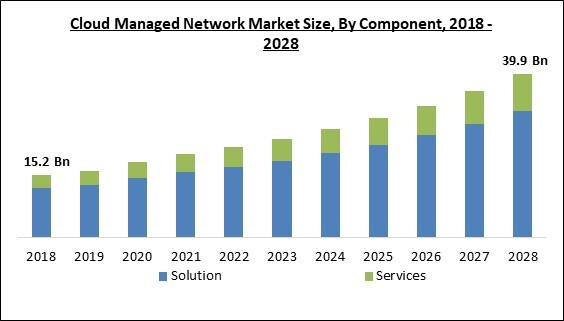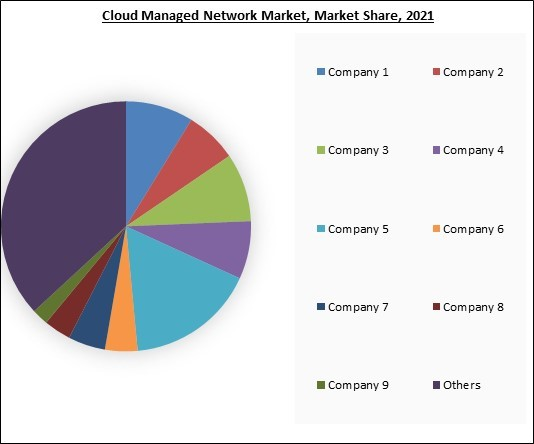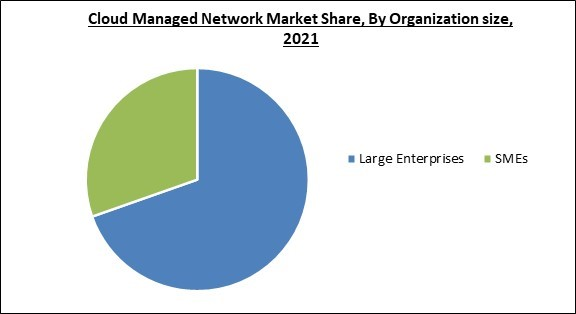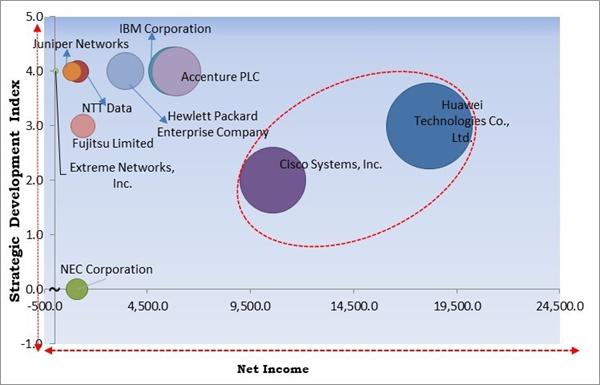The Global Cloud Managed Network Market size is expected to reach $39.9 billion by 2028, rising at a market growth of 10.4% CAGR during the forecast period.
Cloud computing is an emergingtechnology that allows users to share resources to maximize the use of IT resources. To speed up the networking and development processes, businesses are implementing new technologies, including artificial intelligence,the internet of things (IoT),and mobile app hosting. In addition, any corporation employee can use the internet due to cloud computing's vast scale processing capability. 'Cloud networking'refers to using wide-area networking to centrally access all networking resources.
Many programs, including network administration, virtual desktops, voice-over-internet protocol (VoIP), and unified networks, are run on enterprise servers. The managed cloud networking infrastructure guarantees data transmission security and anonymity, as well as high availability of data that is always accessible to users. To maintain network performance on cloud networking, businesses can move their entire network operation to the cloud using a managed cloud platform.
To enhance their data transmission and communication network performance, businesses are anticipated to embrace private cloud &public cloud platforms. A managed cloud platform is provided by several businesses for the creation, deployment, and administration of applications. The market for cloud managed network is anticipated to be driven by the increase in demand for cloud networking to enhance productivity and streamline application deployment.
Managed cloud networking platforms simplify networking by lowering the complexity and expense of distributed organizational deployments. As a result, cloud networking gives businesses a chance to spend less money upfront on IT networking resources. A managed cloud platform with cutting-edge capabilities, including hosting, relational databases, elastic computing,object storage, and artificial intelligence, is anticipated to be used by businesses. These capabilities are anticipated to introduce a fresh approach to cloud computing applications.
The leading players in the market are competing with diverse innovative offerings to remain competitive in the market. The illustration shows the percentage of revenue shared by some of the leading companies in the market. The leading players of the market are adopting various strategies in order to cater demand coming from the different industries. The key developmental strategies in the market are Acquisitions.
The major strategies followed by the market participants are Acquisitions. Based on the Analysis presented in the Cardinal matrix; Cisco Systems, Inc. and Huawei Technologies Co., Ltd. are the forerunners in the Cloud Managed Network Market. Companies such as Accenture PLC, Hewlett Packard Enterprise Company, and IBM Corporation are some of the key innovators in Cloud Managed Network Market.
The market research report covers the analysis of key stake holders of the market. Key companies profiled in the report include Cisco Systems, Inc., IBM Corporation, Huawei Technologies Co., Ltd. (Huawei Investment & Holding Co., Ltd.), NTT Data Corporation, Hewlett Packard Enterprise Company (HP Development Company L.P.), Juniper Networks, Inc., Accenture PLC, Fujitsu Limited, NEC Corporation and Extreme Networks, Inc.
Cloud computing is an emergingtechnology that allows users to share resources to maximize the use of IT resources. To speed up the networking and development processes, businesses are implementing new technologies, including artificial intelligence,the internet of things (IoT),and mobile app hosting. In addition, any corporation employee can use the internet due to cloud computing's vast scale processing capability. 'Cloud networking'refers to using wide-area networking to centrally access all networking resources.
Many programs, including network administration, virtual desktops, voice-over-internet protocol (VoIP), and unified networks, are run on enterprise servers. The managed cloud networking infrastructure guarantees data transmission security and anonymity, as well as high availability of data that is always accessible to users. To maintain network performance on cloud networking, businesses can move their entire network operation to the cloud using a managed cloud platform.
To enhance their data transmission and communication network performance, businesses are anticipated to embrace private cloud &public cloud platforms. A managed cloud platform is provided by several businesses for the creation, deployment, and administration of applications. The market for cloud managed network is anticipated to be driven by the increase in demand for cloud networking to enhance productivity and streamline application deployment.
Managed cloud networking platforms simplify networking by lowering the complexity and expense of distributed organizational deployments. As a result, cloud networking gives businesses a chance to spend less money upfront on IT networking resources. A managed cloud platform with cutting-edge capabilities, including hosting, relational databases, elastic computing,object storage, and artificial intelligence, is anticipated to be used by businesses. These capabilities are anticipated to introduce a fresh approach to cloud computing applications.
COVID-19 Impact Analysis
The most notable development in the data center industry has been the robust demand for providers of essential services, such as video conferencing applications likecloud collaboration platforms, Zoom,social media platforms, educational portals, VPN specialists, and gaming and streaming media. Despite this, just after the initial months, the cloud services saw an upsurge in demand, positively impacting the cloud managed network market. Thus, the market witnessed a slowdown during the initial months of COVID but eventually profited afterward.Market Growth Factors
Growing adoption of AI & ML supporting market expansion
A significant portion of automated, real-time smart decisions for shifting traffic among clouds is already being fulfilled by AI. With their autonomic-oriented algorithms, AI and ML are expected to serve as the orchestrators of the enterprise WAN of the future. Instead of reacting to problematic network conditions like packet loss,latency,and jitter, AI will use its predictive abilities to direct traffic to the optimum circuits and paths, comprehending the purpose of the application and consistently providing a dependable user experience. As a result, the cloud managed network market is predicted to expand significantly throughout the projection period.The leading players in the market are competing with diverse innovative offerings to remain competitive in the market. The illustration shows the percentage of revenue shared by some of the leading companies in the market. The leading players of the market are adopting various strategies in order to cater demand coming from the different industries. The key developmental strategies in the market are Acquisitions.
Cloud managed networks are easy to set up, manage and configure
'virtual stacking'enables IT administrators to set ports en masse on internet-connected switches, regardless of where these switches are physically located on the planet. Administering IT infrastructure via the cloud necessitates less investment in on-premises setup, resulting in a substantial decrease in personnel expenses. As a result of these advantages of cloud managed networks and the lower staff cost, businesses are becoming increasingly interested in implementing cloud managed networks, which would lead to the expansion of the market. This would lead to the expansion of the market.Market Restraining Factors
Data privacy & security concerns associated with cloud managed networks
MSPs can assist enterprises in maintaining appropriate safety and privacy precautions for the data deployed via the cloud. In addition, they provide comprehensive network protection & encryption for their clientele as an added layer of safety. It is anticipated that a lack of awareness about cloud managed networking solutions among businesses in developing countries, particularly in rural areas or places where information technology services and network connectivity are unavailable, will be a main hindrance to the expansion of the market.Component Outlook
Based on component, the cloud managed network market is segmented into solution and services. In 2021, the solution segment held the highest revenue share in the cloud managed network market. Businesses are progressively adopting cloud managed solutions to enhance their business processes and provide more responsive services to their consumers. In addition, advantages such as cost savings, better efficiency and flexibility, and less downtime have contributed to the rise in demand for cloud managed network solutions.Deployment Model Outlook
By deployment model, the cloud managed network market is bifurcated into private cloud and public cloud. In 2021, the private cloud segment garnered a significant revenue share in the cloud managed network market. Private clouds are designed for special groups or organizations that need data customization and management. Corporations use a private cloud because it offers a highly secure and centralized storage infrastructure. The segment's expansion will be driven by the need to enable firms to better handle their data, hence reducing the risk of data loss and compliance-related difficulties.Organization Size Outlook
On the basis of organization size, the cloud managed network market is classified into large enterprises, and small & medium enterprises. In 2021, the large enterprise segment witnessed the largest revenue share in the cloud managed network market. By constantly reinventing their products and services, these businesses strive to enhance the consumer experience. Managed cloud services provide an end-to-end hosting solution that guarantees consumers a consistent supply of services. Managed service providers in the cloud offer robust infrastructure & digital transformation support to satisfy the expanding business needs of an organization.Vertical Outlook
Based on vertical, the cloud managed network market is fragmented into IT & ITes, BFSI, retail & e-commerce, healthcare & life science, transportation & logistics, manufacturing, media & entertainment, energy & utilities, and other verticals. The BFSI segment recorded a remarkable revenue share in the cloud managed network market in 2021. By evaluating transactional data to estimate risks based on market activity and scoring customers and future clients, the BFSI industry effectively evaluates risks and enables enterprises to make better decisions. As a result of altering evolving technologies, consumer expectations, and alternative business models, banks are putting in place measures that will help them prepare for the future.Regional Outlook
Region wise, the cloud managed network market is analyzed across North America, Europe, Asia Pacific and LAMEA. In 2021, the North America region led the cloud managed network market by generating the largest revenue share. The expansion is mostly related to growing investments by key firms and the government in cloud service usage. In addition, increasing internet penetration and cloud use are other aspects anticipated to boost the market's expansion.The Cardinal Matrix - Cloud Managed Network Market Competition Analysis
The major strategies followed by the market participants are Acquisitions. Based on the Analysis presented in the Cardinal matrix; Cisco Systems, Inc. and Huawei Technologies Co., Ltd. are the forerunners in the Cloud Managed Network Market. Companies such as Accenture PLC, Hewlett Packard Enterprise Company, and IBM Corporation are some of the key innovators in Cloud Managed Network Market.
The market research report covers the analysis of key stake holders of the market. Key companies profiled in the report include Cisco Systems, Inc., IBM Corporation, Huawei Technologies Co., Ltd. (Huawei Investment & Holding Co., Ltd.), NTT Data Corporation, Hewlett Packard Enterprise Company (HP Development Company L.P.), Juniper Networks, Inc., Accenture PLC, Fujitsu Limited, NEC Corporation and Extreme Networks, Inc.
Strategies Deployed in Cloud Managed Network Market
- Mar-2023: Huawei introduced Digital Managed Network Solutions and products intended for carriers' B2B services. The new network solution enables carriers to grasp digital transformation opportunities. The new solution features managed LAN, managed WAN, managed security, and managed DCN, among others.
- Feb-2023: Hewlett Packard Enterprise acquired Athonet, an Italy-based developer of a connectivity platform. The acquisition expands HPE's edge-to-cloud products and solutions offerings.
- Jun-2022: Cisco collaborated with Kyndryl, a US-based information technology company. Through this collaboration, the companies intend to jointly develop new networks, edge computing solutions, private cloud services, etc.
- Apr-2022: Fujitsu introduced Fujitsu Computing as a Service (CaaS). The new solution would provide clients with access to services on the public cloud.
- Apr-2022: NTT Data took over Business Services & Technologies OOD, a Bulgaria-based provider of software solutions. The addition of Business Services & Technologies expands NTT's global managed services capabilities and further expands its shoring offerings in the European Union.
- Feb-2022: IBM took over Neudesic, a US-based provider of application development and cloud computing services. The addition of Neudesic broadens IBM's portfolio of hybrid multi-cloud services and further complements IBM's prior acquisitions.
- Feb-2022: Juniper Networks took over WiteSand, a US-based operator of a cloud-based enterprise network platform. The addition of WiteSand advances the company's efforts to offer next-generation NAC solutions. Further, the WiteSand's NAC technology and engineering team perfectly fits well with Juniper's AI-driven enterprise portfolio.
- Jul-2021: Accenture completed the acquisition of Linkbynet, a France-based provider of outsourcing and consulting services. The addition of Linkbynet improves the capabilities of Accenture Cloud First.
- Aug-2019: Extreme Networks acquired Aerohive Networks, a US-based developer of cloud networking and enterprise Wi-Fi solutions. The acquisition of Aerohive enables Extreme to provide various choices for cloud and on-premises wireless and wired technology.
Scope of the Study
By Component
- Solution
- Services
By Vertical
- IT & ITeS
- BFSI
- Manufacturing
- Retail & Ecommerce
- Media & Entertainment
- Healthcare & Life Sciences
- Transportation & Logistics
- Energy & Utilities
- Others
By Organization size
- Large Enterprises
- SMEs
By Deployment Mode
- Public Cloud
- Private Cloud
By Geography
- North America
- US
- Canada
- Mexico
- Rest of North America
- Europe
- Germany
- UK
- France
- Russia
- Spain
- Italy
- Rest of Europe
- Asia Pacific
- China
- Japan
- India
- South Korea
- Singapore
- Malaysia
- Rest of Asia Pacific
- LAMEA
- Brazil
- Argentina
- UAE
- Saudi Arabia
- South Africa
- Nigeria
- Rest of LAMEA
Key Market Players
List of Companies Profiled in the Report:
- Cisco Systems, Inc.
- IBM Corporation
- Huawei Technologies Co., Ltd. (Huawei Investment & Holding Co., Ltd.)
- NTT Data Corporation
- Hewlett Packard Enterprise Company (HP Development Company L.P.)
- Juniper Networks, Inc.
- Accenture PLC
- Fujitsu Limited
- NEC Corporation
- Extreme Networks, Inc.
Unique Offerings
- Exhaustive coverage
- The highest number of Market tables and figures
- Subscription-based model available
- Guaranteed best price
- Assured post sales research support with 10% customization free
Table of Contents
Chapter 1. Market Scope & Methodology
Chapter 2. Market Overview
Chapter 3. Competition Analysis - Global
Chapter 4. Global Cloud Managed Network Market by Component
Chapter 5. Global Cloud Managed Network Market by Vertical
Chapter 6. Global Cloud Managed Network Market by Organization size
Chapter 7. Global Cloud Managed Network Market by Deployment Mode
Chapter 8. Global Cloud Managed Network Market by Region
Chapter 9. Company Profiles
Companies Mentioned
- Cisco Systems, Inc.
- IBM Corporation
- Huawei Technologies Co., Ltd. (Huawei Investment & Holding Co., Ltd.)
- NTT Data Corporation
- Hewlett Packard Enterprise Company (HP Development Company L.P.)
- Juniper Networks, Inc.
- Accenture PLC
- Fujitsu Limited
- NEC Corporation
- Extreme Networks, Inc.
Methodology

LOADING...












